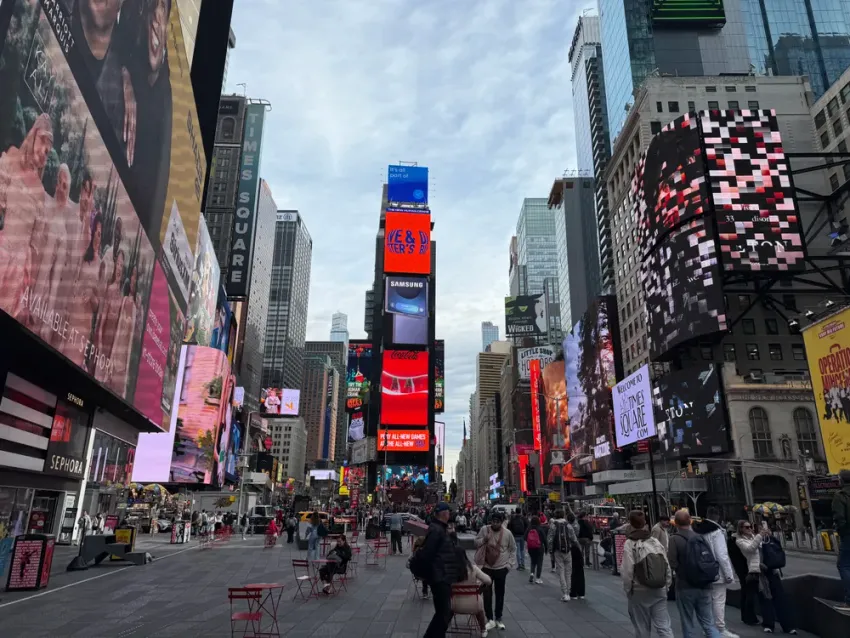Nick Leone is a theater expert who, during his five-decade career, has performed professionally across North America, Europe, and the Middle East. He has directed and choreographed over 50 productions and has taught at some of New York’s finest dance schools, as well as Long Island University. In an interview with the SGN, Leone shared his decades of accumulated knowledge on musical theater, Broadway, and its history in New York City.
In the late 1800s, theater as entertainment became more readily available in the metropolis. The theater district today roughly covers over 30 blocks. Leone explained that the terms “on-Broadway” and “off-Broadway” do not refer to location but rather designate a theater’s capacity. If a venue is above 500 seats, it is considered "on-Broadway”; below that is “off-Broadway.” (Only three on-Broadway theaters — the Palace, the Broadway, and the Winter Garden — are located on Broadway itself.)
Although Times Square is the center of the district today, according to Leone that was not always the case. In George M. Cohan’s song “Give My Regards to Broadway,” he wrote, “Remember me to Herald Square!” for his influential 1904 play Little Johnny Jones. Herald Square is where Macy’s flagship store stands today, just outside the district.
Changes
“Every now and then, a landmark musical comes along that pushes the genre forward,” Leone said when describing Broadway’s long history. The idea of the modern-day musical is considered a distinctly new and American invention, Leone said. Precursors existed, like operettas and musical reviews; however, it was not until 1943, when Oklahoma opened that everything changed. According to Leone, it was the first production with songs and accompanying dances that were created with the purpose of furthering the plot; it created a blueprint for all future musicals.
Broadway has also been a tool for social commentary and change. In 1929, Showboat, created by Jerome Kern and Oscar Hammerstein II, was the first to address serious subjects in a Broadway production. The plot focuses on racial prejudice, and the song “"Ol' Man River," sung by Jules Bledsoe, made him the first Black male star on Broadway.
Leone also noted how Broadway performances have a history of pushing racial boundaries. The musical Hello, Dolly! debuted on Broadway in 1964 with an all-white cast, but in 1967, producer David Merrick refitted the show with an all-Black cast. Pearl Bailey and Cab Calloway played the lead roles, landing Bailey on the cover of Life magazine. The 1994 Broadway revival of Carousel casted Black actress Audra McDonald as Carrie Pipperidge, a traditionally white character; she won a Tony Award for Best Featured Actress for her performance.
Queering Broadway
Gay male characters began surfacing in shows during the 1950s, especially off-Broadway, Leone said. By the 1970s, Gay characters on stage had become increasingly commonplace.
“I would look at the on-Broadway and off-Broadway roster, and every single show seemed to have an obligatory Gay character. It had to be about something Gay,” Leone recalled.
Leone highlighted shows that pushed for societal acceptance of the Queer community, specifically Gays and Lesbians. The Boys in the Band (1968) was the first play with all Gay characters. Although it was performed off-Broadway, Leone said, “It just rocked the theater world.”
Broadway was one of the first institutions to tackle HIV/AIDS awareness. There were several notable plays about the plight of people dying during the HIV/AIDS epidemic, with 1991’s Angels in America impacting Leone the most.
Broadway Cares/Equity Fights AIDS is a nonprofit organization founded in 1987 to raise money for awareness of and research into the disease. After performances, the cast speak to the audience about the importance of the organization, followed by passing donation buckets around the theater.
Broadway gets commercialized
Not all cultural shifts in Broadway have been good, according to Leone. In the 1990s, Disney made a deal with NYC to help revitalize the area. After renovating the New Amsterdam Theater, Disney opened The Lion King.
Leone described how Disney moves older productions to another one of its theaters once a new show opens. But it’s what Disney does during its shows that upset Leone most. At intermission, especially the kid-friendly performances, vendors walk the aisles selling water and merchandise to the audience.
“To me, that's terrible. That's the bad thing Disney brought to the commercialization on Broadway,” Leone said.
The Broadway district today is a dual-edged sword for Leone, because on the one hand, it has become a much safer area for people to visit, but on the other, it is much more gentrified and losing some of its distinctive character.
“Before, there were local places. There wasn't an Olive Garden at one end and a Chili's at the other. It was just more unique,” Leone said.
Tips for visiting Broadway
As a theater expert, Leone recommends that for productions with big casts and lots of elaborate special effects, or for musicals with choreography, the best seats are at the center and farther back.
“Don’t buy seats too close unless it's a very small, intimate play. Like if you're going to go see Waiting for Godot, there's only two characters for that. You want to see the illusion they're creating for you,” Leone noted.
He recommends buying tickets at the physical box office whenever possible. Agencies and third-party vendors lead to additional charges, and the tickets aren’t reflective of what’s available. For instance, when Ticketmaster sells out, that means its chunk of the tickets are gone. Tickets may still be available at the venue.
“It's old-fashioned, but it's still the best way to do it” Leone stated.
If people choose to buy tickets online, Leone said to “beware, beware, beware” of fake websites and to only go to the show’s official website.
Support the Seattle Gay News: Celebrate 50 Years with Us!
As the third-oldest LGBTQIA+ newspaper in the United States, the Seattle Gay News (SGN) has been a vital independent source of news and entertainment for Seattle and the Pacific Northwest since 1974.
As we celebrate our 51st year, we need your support to continue our mission.
A monthly contribution will ensure that SGN remains a beacon of truth and a virtual gathering place for community dialogue.
Help us keep printing and providing a platform for LGBTQIA+ voices.
How you can donate!
Using this Link
Text "SGN" to 53-555
Or Scan the QR code below!



